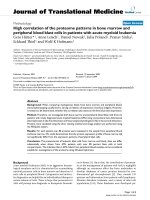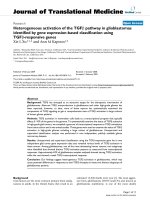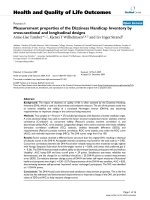báo cáo hóa học:" Osteoblastoma-like Osteosarcoma of the Cuboid: A Case Report" potx
Bạn đang xem bản rút gọn của tài liệu. Xem và tải ngay bản đầy đủ của tài liệu tại đây (918.94 KB, 5 trang )
CAS E REP O R T Open Access
Osteoblastoma-like Osteosarcoma of the Cuboid:
A Case Report
Navin L Kumar
1*
, Andrew E Rosenberg
1,2
, Kevin A Raskin
1,3
Abstract
Osteosarcoma most commonly arises in the long bones of the skeleton, and rarely develops in the bones of the
foot. We describe a patient who presented with left foot pain, whose radiographic evaluation revealed a lytic
destructive mass in the cuboid bone. A biopsy showed an osteoblastoma-like variant of osteosarcoma and the
patient was treated with preoperative chemotherapy and amputation. Osteosarcoma of the foot is uncommon and
the literature reveals that it is often associated with a delay in diagnosis.
Background
Osteosarcoma is a malignant neoplasm of bone in which
tumor cells produce neoplastic bone matrix [1]. It is the
most common sarcoma of bone, and follows multiple
myeloma as the second most common primary malig-
nancy of the skeleton [2]. Osteosarcoma usually affects
patients in the late teenage years, and predominantly
originates in the long bones, particularly around the
knee [1]. Rarely, osteosarcoma develops in the bones of
the foot [3]. This case report describes a patient who
was found to have osteosarcoma of the cuboid bone
after developing pain and swelling of his left foot.
Although initial diagnostic tests suggested that the
lesion was benign, an open biopsy revealed a hi gh grade
osteoblastoma-like variant of osteosarcoma, which to
our knowledge is the first case published involving the
cuboid bone.
Case Presentation
Case Report
A 32 year old man presented to an outside hospital with
a one month history of left foot pain. He recalled that
the pain started after he had twisted his ankle during a
round of golf. Since that time, the pain had persisted
and was most severe along the lateral aspect of his left
foot. On physical examination, there was moderate swel-
ling over the lateral aspect of the hindfoot, with point
tenderness directly over the cuboid bone. The remainder
of the foot exam was normal. A plain radiograph of the
left foot showed a large oval, cystic mass within the
cuboid bone that had relatively well-defined margins but
with obfuscation of the lateral cortex (figure 1). There
was no signifi cant periosteal reaction, and no soft tissue
mass or calcifications were apprecia ted. A computed
tom ography (CT) scan showed an expansile lytic lesi on,
which was contained by an extremely thin shell of reac-
tive bone (figure 2). T he margins of the lesion were cir-
cumscribed, but not sclerotic, and there were no
internal foci of mineralization. There was also no evi-
dence of ankle effusion.
Magnetic resonance imaging (MRI) demonstrated a
gadolinium-enhancing lesion, with increased signal
intensity on the T2 weighted image (figure 3). The
lesion demonstrated slight heterogeneous enhancement,
and there was no associated pathologic fracture or soft
tissue mass identified. There was, however, extensive
edema in the adjacent soft tissues . A two-phase techne-
tium-99m-methylene diphosphonate (Tc99 M MDP)
was obtained and demonstrated marked uptake corre-
sponding to the left cuboid lesion, with no other foci of
significant uptake (figure 4). Based on the clinical and
radiographic findings, the lesion was thought to repre-
sent a benign, but potentially locally aggressive neo-
plasm such as giant cell tumor of bone.
The patient’s pain became progressively more severe
and he no longer was able to weight bear. An open
biopsy was performed and a frozen section revealed a
giant cell rich lesion with atypical mononuclear stromal
cells and areas of extracellular eosinophilic matrix. The
differential diagnosis was an atypical giant cell tumor
versus a variant of osteosarcoma. A discussion regarding
* Correspondence: rd.edu
1
Harvard Medical School, Boston, MA 02115, USA
Full list of author information is available at the end of the article
Kumar et al. Journal of Orthopaedic Surgery and Research 2010, 5:52
/>© 2010 Kumar et al; licensee BioMed Central Ltd. This is an Open Access article distributed under the terms of the Creative Commons
Attribution Lic ense (http://creativec ommons.org/licenses/by/2.0), which permits unrestricted use, distribution, and reproduction in
any medium, provided the original work is properly cited.
immediate management concluded that it would be best
to thoroughly curette the lesion and pack the defect
with cement, which would stabilize the lateral column
and be adequate therapy for a benign lesion. If, however,
the histologic analysis of the additional tissue demon-
strated an osteosarcoma, then an ampution would be
performed at a later date and the curettage would not
have compromised treatment for this type of tumor.
Evaluation of the entire tissue specimen revealed a
neoplasm that varied in morphology. The majority of
the tumor was solid and in regions consisted of ran-
domly interconnecting trabeculae of woven bone
rimmed prominently by neoplastic osteoblasts. The
plumposteoblastshadabundanteosinophiliccytoplasm
and round or oval nuclei with fine chromatin. The inter-
trabecular spaces were filled with loose vascular connec-
tive tissue containing cong ested capillarie s, extravasated
red blood cells, and scattered osteoclast-t ype giant cells.
The morphologic features were reminiscent of osteo-
blastoma (figure 5). In other areas, however, the neo-
plastic osteoblasts grew in solid aggregates, were
cytologically mali gnant with nuclea r enlargement, co arse
chromatin, and hyperchromasia, demonstrated many
mitoses and produced coarse lace-like neoplastic bone
typical of a high grade osteosarcoma (figure 6) . Based
on the histologic features the tumor was diagnosed as a
high grade osteoblastoma-like variant of osteosarcoma.
A staging computed tomography (CT) scan of the
chest showed no evidence of metastatic disease. The
patient was started on an appropriate chemotherapy
regimen and subsequently unde rwent a below the kne e
amputation (BKA). Dissection of the cuboid revealed
residual small foci of osteosarcoma in the bone neigh-
bouring the cement plug, as well as in the soft tissues
immediately adjacent to the bone. No vascular invasion
was identified and all m argins of resection were widely
negative.
Discussion
Osteosarcoma is a malignant neoplasm with a spectrum
of biological potential although most are high grade and
behave in an aggressive fashion. This form of cancer
usually affects patients in the 2
nd
half of the 2
nd
decade
of life [1]. When osteosarcoma develops in an older
Figure 1 Plain radiograph of the left foot. The radiograph
demonstrates a large lytic lesion of the left cuboid.
Figure 2 Computed tomography (CT) of the left foot.TheCT
scan demonstrates a 2-3 cm lytic lesion within the left cuboid, with
extreme thinning of the overlying cortex and possible cortical
interruption.
Figure 3 Magnetic resonance imaging (MRI) of the left foot.
The MRI demonstrates the entire cuboid bone replaced with
abnormal signal intensity. There is no associated soft tissue mass.
Kumar et al. Journal of Orthopaedic Surgery and Research 2010, 5:52
/>Page 2 of 5
patient, a pre-disposing condition such as Paget’s disease
of bone or prior radiation exposure to the affected bone
should be susp ected [4]. Osteosarcoma most commonl y
arises within the medullary cavity of the metaphyseal
region of long bones [5]. The distal femur, proximal
tibia, and proximal humerus are most commonly
affected.
It is exceedingly uncommon for osteosarcoma to origi-
nate in the bones of the foot. In a review of all cases of
osteosarcoma from 1911-1992 at the Rizzoli Orthopedic
Institute in Italy, the inci dence of osteosarco ma in the
foot was 0.6%, wit h 12 identified cases of the foot out of
a total of 1,929 osteosarcomas [3]. The calcaneus was
most commonly involved, followed b y the talus. The
most common presenting symptom of osteosarcoma of
the foot is pain that is persistent and may be worse at
night [ 1]. Often, the patient may recall a singula r event
that precipitated the symptoms. Physical exam
Figure 4 A Tc99 M Bone Scan. The bone scan demonstrates intense uptake localized to the left cuboid lesion, with no evidence of metastatic
disease.
Kumar et al. Journal of Orthopaedic Surgery and Research 2010, 5:52
/>Page 3 of 5
frequently reveals swelling and pain associated with a
mass. Initial evaluation should include an x-ray, followed
by a CT scan and/or MRI.
Classically, osteosarcoma appears as a mixed lytic and
blastic mass with poorly defined margins, cortical
destruction, and a soft tissue mass [1,6]. However, in
some cases it may be very difficult to differentiate osteo-
sarcoma from benign lesions such as chondroblastoma,
enchondroma, giant cell tumor, osteoblas toma or aneur-
symal bone cyst, even with the advent of CT and MRI
[6,7]. Accordingly, a tissue biopsy is required to establish
the diagnosis.
Osteosarcoma of the foot has some clin ical features
that differ from those associated with osteosarcoma of
long bone. In term s of age of presentation, patients with
osteosarcoma of the foot are older, with a mean age of
diagnosis at 32 years old [2]. In contrast, conventional
osteosarcoma is most common in children and adoles-
cents, with the peak age between 15 and 20 years old
[3]. In addition, patients with osteosarcoma of the foot
commonly have a long delay from the time of onset of
symptoms to diagnosis, with the mean interval greater
than 2 years [3]. Osteosarcoma of the long bo nes, how-
ever, is usually diagnosed within months of the symp-
tom onset [2]. Lastly, osteosarcomas of the foot
generally are lower grade than the typical osteosarcoma
affecting long bones [3]. In a study by Biscaglia et al,
42% of the cases involving the foot were low grade,
compared to the ty pical 5-10% of conventional osteosar-
comas classified as low grade [3]. In sum, osteos arcomas
of the foot differ from osteosarcomas of the long bones
in terms of age of presentation, time from symptom
onset to diagnosis, and histological grade - all important
considerations when evaluating a patient with a suspi-
cious foot lesion.
Osteosarcoma is classified histologically into a variety
of different subtypes with the most common being
chondroblastic [8]. Fox et al. reported a case of chon-
droblastic osteosarcoma involving the cuboid bone,
which also featured a prominent giant cell component
that complicated the ini tial diagnosis [5]. The osteoblas-
toma-like v ariant is a rare form and notable because of
its morphologic similarity to osteoblastoma, which is a
benign primary bone-forming tumor [9]. The tumor in
this case report was considered malignant because of
the severe cytologic atypia and hig h prolifera tive activity
manifested by the tumor cells.
Important distinctions exist between osteoblastoma-
like osteosarcoma and conventional osteosarcoma.
Bertoni et al. reviewed a series of 11 patients with osteo-
blastoma-like osteosarcoma, and found that the average
age of presentation was older at 29 years of age [10].
The lesions were low-grade, but had a high rate of
recurrence if adequate surgical margins were not
achieved. The most common location was the tibia fol-
lowed by the spine. Of note, the authors also found that
osteoblastoma-like osteosarcoma involved bones not
commonly affected b y conventional osteosarcoma,
including the small bones of the skull and face.
This case report, in summary, presents the rare diag-
nosis of osteoblastoma-like variant of osteosarcoma aris-
ing in the cuboid bone which, to the best of our
knowledge, is the first published case. This repo rt high-
lights the importance of tissue biopsy in the evaluation
of suspicious foot lesions, the limitations of imaging stu-
dies, and the challenges of pathologic analysis in
Figure 6 Permanent section of the left cuboid resembling
osteosarcoma. Area of tumor diagnostic of osteosarcoma in which
the tumor cells are large, hyperchromatic, mitotically active, and
associated with coarse lace-like woven bone.
Figure 5 Permanent section of the left cuboid resembling
osteoblastoma. Region of tumor resembling osteoblastoma
composed of well formed interconnecting trabeculae of woven
bone lined by prominen cytologically banal osteoblasts. The stroma
consists of loose fibrovascular tissue.
Kumar et al. Journal of Orthopaedic Surgery and Research 2010, 5:52
/>Page 4 of 5
establishing a diagnosis when elements of both benign
and malignant etiologies co-exist.
Competing interests
The authors declare that they have no competing interests.
Authors’ contributions
NLK conceived the idea and wrote the paper.
AER was responsible for editing and approving the final manuscript
KAR was responsible for editing and approving the final manuscript.
All authors read and approved the final manuscript.
Consent
Written informed consent was obtained from the patient for publication of
this case report and any accompanying images. A copy of the written
consent is available for review by the Editor-in-Chief of this journal.
Author details
1
Harvard Medical School, Boston, MA 02115, USA.
2
Harvard Medical School,
Department of Pathology – WRN 2, Massachusetts General Hospital, 55 Fruit
Street, Boston, MA 02114, USA.
3
Harvard Medical School, Orthopaedic
Oncology Service, Massachusetts General Hospital, 55 Fruit Street, Yawkey
Outpatient Center, Suite 3B, Boston, MA 02114, USA.
Received: 15 March 2010 Accepted: 6 August 2010
Published: 6 August 2010
References
1. Unni KK: Osteosarcoma of bone. J Orthop Sci 1998, 3(5):287-94.
2. Choong PF, Qureshi AA, Sim FH, Unni KK: Osteosarcoma of the foot: a
review of 52 patients at the mayo clinic. Acta Orthop Scand 1999,
70(4):361-4.
3. Biscaglia R, Gasbarrini A, Böhling T, Bacchini P, Bertoni F, Picci P:
Osteosarcoma of the bones of the foot–an easily misdiagnosed
malignant tumor. Mayo Clin Proc 1998, 73(9):842-7.
4. Wick MR, Siegal GP, Unni KK, McLeod RA, Greditzer HG: Sarcomas of bone
complicating osteitis deformans (Paget’s disease): fifty year’s experience.
Am J Surg Pathol 1981, 5(1):47-59.
5. Fox C, Husain ZS, Shah MB, Lucas DR, Saleh HA: Chondroblastic
osteosarcoma of the cuboid: a literature review and report of a rare
case. J Foot Ankle Surg 2009, 48(3):388-93, Review.
6. Lee EY, Seeger LL, Nelson SD, Eckardt JJ: Primary osteosarcoma of a
metatarsal bone. Skeletal Radiol 2000, 29(8):474-6.
7. Rhee JH, Lewis RB, Murphey MD: Primary osseous tumors of the foot and
ankle. Magn Reson Imaging Clin N Amb 2008, 16(1):71-91, vi.
8. Papagelopoulos PJ, Galanis EC, Vlastou C, Nikiforidis PA, Vlamis JA,
Boscainos PJ, Fragiadakis EG, Stamos KG, Pantazopoulos T, Sim FH: Current
concepts in the evaluation and treatment of osteosarcoma. Orthopedics
2000, 23(8):858-67.
9. Hermann G, Klein MJ, Springfield D, Abdelwahab IF: Osteoblastoma like
osteosarcoma. Clin Radiol 2004, 59(1):105-8.
10. Bertoni F, Bacchini P, Donati D, Martini A, Picci P, Campanacci M:
Osteoblastoma-like osteosarcoma. The Rizzoli Institute experience. Mod
Pathol 1993, 6(6):707-16.
doi:10.1186/1749-799X-5-52
Cite this article as: Kumar et al.: Osteoblastoma-like Osteosarcoma of
the Cuboid: A Case Report. Journal of Orthopaedic Surgery and Research
2010 5:52.
Submit your next manuscript to BioMed Central
and take full advantage of:
• Convenient online submission
• Thorough peer review
• No space constraints or color figure charges
• Immediate publication on acceptance
• Inclusion in PubMed, CAS, Scopus and Google Scholar
• Research which is freely available for redistribution
Submit your manuscript at
www.biomedcentral.com/submit
Kumar et al. Journal of Orthopaedic Surgery and Research 2010, 5:52
/>Page 5 of 5









